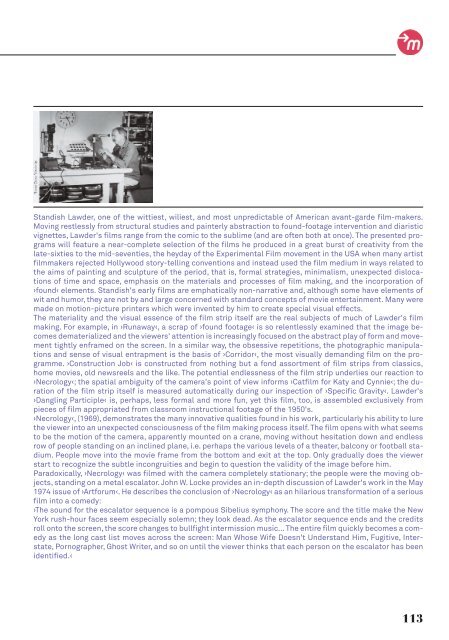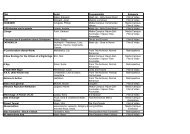Retrospektive - EMAF
Retrospektive - EMAF
Retrospektive - EMAF
Erfolgreiche ePaper selbst erstellen
Machen Sie aus Ihren PDF Publikationen ein blätterbares Flipbook mit unserer einzigartigen Google optimierten e-Paper Software.
Standish Lawder, one of the wittiest, wiliest, and most unpredictable of American avant-garde film-makers.<br />
Moving restlessly from structural studies and painterly abstraction to found-footage intervention and diaristic<br />
vignettes, Lawder's films range from the comic to the sublime (and are often both at once). The presented programs<br />
will feature a near-complete selection of the films he produced in a great burst of creativity from the<br />
late-sixties to the mid-seventies, the heyday of the Experimental Film movement in the USA when many artist<br />
filmmakers rejected Hollywood story-telling conventions and instead used the film medium in ways related to<br />
the aims of painting and sculpture of the period, that is, formal strategies, minimalism, unexpected dislocations<br />
of time and space, emphasis on the materials and processes of film making, and the incorporation of<br />
›found‹ elements. Standish's early films are emphatically non-narrative and, although some have elements of<br />
wit and humor, they are not by and large concerned with standard concepts of movie entertainment. Many were<br />
made on motion-picture printers which were invented by him to create special visual effects.<br />
The materiality and the visual essence of the film strip itself are the real subjects of much of Lawder's film<br />
making. For example, in ›Runaway‹, a scrap of ›found footage‹ is so relentlessly examined that the image becomes<br />
dematerialized and the viewers' attention is increasingly focused on the abstract play of form and movement<br />
tightly enframed on the screen. In a similar way, the obsessive repetitions, the photographic manipulations<br />
and sense of visual entrapment is the basis of ›Corridor‹, the most visually demanding film on the programme.<br />
›Construction Job‹ is constructed from nothing but a fond assortment of film strips from classics,<br />
home movies, old newsreels and the like. The potential endlessness of the film strip underlies our reaction to<br />
›Necrology‹; the spatial ambiguity of the camera's point of view informs ›Catfilm for Katy and Cynnie‹; the duration<br />
of the film strip itself is measured automatically during our inspection of ›Specific Gravity‹. Lawder's<br />
›Dangling Participle‹ is, perhaps, less formal and more fun, yet this film, too, is assembled exclusively from<br />
pieces of film appropriated from classroom instructional footage of the 1950's.<br />
›Necrology‹, (1969), demonstrates the many innovative qualities found in his work, particularly his ability to lure<br />
the viewer into an unexpected consciousness of the film making process itself. The film opens with what seems<br />
to be the motion of the camera, apparently mounted on a crane, moving without hesitation down and endless<br />
row of people standing on an inclined plane, i.e. perhaps the various levels of a theater, balcony or football stadium.<br />
People move into the movie frame from the bottom and exit at the top. Only gradually does the viewer<br />
start to recognize the subtle incongruities and begin to question the validity of the image before him.<br />
Paradoxically, ›Necrology‹ was filmed with the camera completely stationary; the people were the moving objects,<br />
standing on a metal escalator. John W. Locke provides an in-depth discussion of Lawder's work in the May<br />
1974 issue of ›Artforum‹. He describes the conclusion of ›Necrology‹ as an hilarious transformation of a serious<br />
film into a comedy:<br />
›The sound for the escalator sequence is a pompous Sibelius symphony. The score and the title make the New<br />
York rush-hour faces seem especially solemn; they look dead. As the escalator sequence ends and the credits<br />
roll onto the screen, the score changes to bullfight intermission music... The entire film quickly becomes a comedy<br />
as the long cast list moves across the screen: Man Whose Wife Doesn't Understand Him, Fugitive, Interstate,<br />
Pornographer, Ghost Writer, and so on until the viewer thinks that each person on the escalator has been<br />
identified.‹<br />
113











